A couple of years ago I went on book tour in April and added three new parks — Safeco, AT&T and the Big A — to my ledger of stadiums visited. I just got back from another book tour, one that followed the Johnny Cashian itinerary of Indianapolis-Chicago-St. Louis-Seattle-Carlsbad-San Francisco-Phoenix-Houston-Nashville, leading me to conclude that recently I have indeed been everywhere, man.
This time around, that everywhere included four new parks. Last week I wrote about finally getting to go to Wrigley Field; here’s a recounting of the rest of my ballpark adventures.
The second stop on the GEBNBT ’14 was O.co Coliseum, the home of the Oakland A’s. Here’s Greg’s take from 14 years ago, when it was Network Associates Coliseum. My take: The O.co is a giant pile of concrete that should be demolished posthaste, with the rubble used to build statues of Lew Wolff and Bud Selig with their pants at their knees while they piss on the city of Oakland.
Selig’s right to be half of such a monument is easily understood; his spavined final years as commissioner will end with some imaginary committee continuing to “study” whether the A’s should go to San Jose, stay in Oakland, return to Kansas City or Philadelphia, or cease to exist after they all drown in another sewage backup. (Undoubtedly the commissioner is busy preventing the Mets from being run like a fourth-rate orphanage and keeping some nihilistic con man from turning the Marlins into a cynical three-card monte game. Oh wait.) As for Wolff, I was surprised to hear Bay Area fans lambaste him, mostly for having ignored clear signals he had no path to setting up shop in San Jose and for actively resisting plans for a new stadium next to Oakland’s thriving Jackson Square neighborhood. I trust the intensity of their venon; if you’ve studied the issue more than I have, I’d be interested in a good explainer.
Anyway, the O.co struck me as a Mad Max version of Shea. Instead of Shea/Citi’s tangle of chop shops and unpaved streets and rumbling els, you get caged walkways leading over industrial yards. Eventually, the caged walkways dump you in the vicinity of an ugly gray concrete pile that rises from a weird hill of xeroscaped dirt, which you search for entrances a la Tomb of Horrors.
The O.co’s employees would fit in at Shea too. The O.co has metal detectors, though not enough of them — more were waiting forlornly inside, of no use to anyone. The people running the metal detectors that were in use didn’t seem to have ever seen such devices before, leading to long lines that moved when attendants got distracted, which they did often enough that one’s faith in the deterrent value of the metal detectors became vestigal. At one point one employee dragged a barrier across the end of a line and then wandered away; a couple of minutes later another employee happened by, scratched his head and then shoved the barrier aside again. I used to explain Shea to the uninitiated by saying that it was like a DMV with baseball in it; well, the O.co is like a Supermax with baseball in it.
If you’re thinking that’s unfair, you’re right — prisons are run a lot better than this place. No one at the O.co seems to have thought about how lines should work — every concessions stand’s line goes straight out into the concourse, blocking the path of fans trying to reach their seats. So you go about 25 feet, hit an insane bottleneck created by people trying to buy a beer or a hot dog, wait patiently to clear the area, then repeat the process. A bright eight-year-old with a modest budget for Tensa-barriers could fix this problem in about half a day; no one at the O.co seems to understand something’s wrong.
Once you reach your seat, you can appreciate the quirks of the place — until you notice that none of them were put there on purpose. The legendary foul territory is even more amazing up close, except that you aren’t up close. We were in pretty good seats — sixth row down the right-field line — but home plate was still a distant rumor. Seriously, you could put a decent-sized street of suburban houses on either side of the baselines in Oakland and still play ball. Never mind what it does to the game — it’s self-evident suicide for selling fancy seats. The scoreboard is the old Shea Lite Brite type (I flashed back to INSANE APE sightings in support of Kevin Appier). And 95% of the upper deck has been turned into a huge, forlorn semicircular A’s ad.
For all this, the park itself isn’t too bad — the view of the mountains was destroyed long ago by Mount Davis, but the music’s pretty good and the fans are great. I can’t say that enough — we were surrounded by East Bay gangbanger-looking dudes, merry bearded drunks, families with hyperactive kids and old sun-leathered military types. Everybody got along swell and everybody was mad for the A’s, who paid them back by stomping the Nationals behind a pair of three-run homers from Derek Norris. Once you’re inside the O.co, the game’s the thing, and that’s not all bad.
But the game’s the thing in Wrigley Field too. The difference is Wrigley Field is a remnant of baseball in a simpler age, while the O.co is a living fossil from an era of bad decisions, still with us because of a recalcitrant owner and a negligent commissioner. The A’s are a good team; their fans are great fans. They deserve so, so, so much better than this.
My next stop was Chase Field, home of the Diamondbacks. The D’backs are a deeply weird team, one given to overhauling rosters and philosophies and uniforms at a dizzying pace. They’ve always bugged me on some level — I suspect I’d despise them if I had to see them as often as I do the Marlins. Part of it is the uniforms — the Diamondbacks aren’t quite the sartorial tire fire on display down in Miami, but they make up for it by switching madly between bad ideas: random colors, the stupid snake as D, and the stupider “db” as snake head. I once described their brand identity as “Barfed-Up Pueblo, a dog’s breakfast of vaguely Southwestern motifs run through a blender by a meth-addled dude in a trailer,” and I think that pretty much summed it up.
So how’s their park? Similarly addled. It’s not a bad place to see a baseball game, by any means. But like its team, it’s … deeply weird.
Some aspects of Chase Field work pretty well. The customer-service people I met were unfailingly nice and good at their jobs. The park presents a friendly face to the city outside it, leading you under a covered concourse to a rotunda with a giant map of Arizona on the floor and the D’backs’ World Series trophy prominently and proudly displayed, along with uniforms once worn by Randy Johnson and Luis Gonzalez. Inside, you’re likely to run into oversized mascots of those two, along with a giant Matt Williams and Mark Grace. Peculiar? To say the least — I can’t think of another team that’s turned living ballplayers of relatively recent vintage into mascots, and it was a bit strange to sit behind Nationals manager Matt Williams as he watched a massive cartoon version of himself participate in a between-innings race. But the fans seemed to like it, and it’s harmless enough.
Chase Field is also a rarity among today’s ballparks in that the people who run it have thought about fans of more modest means. A lot of the concession stands have value items — you can get a hot dog, 12. oz drink or a popcorn for $1.50, and a beer for $4. For a family that doesn’t have a lot of money but wants to take kids to the park, that can make a big difference — the parents don’t have to panic about spending a week’s pay at the park and the kids don’t feel like they’re missing out. I was curious, so I tried the $1.50 dog alongside the $7 Sonoran dog, a bacon-wrapped gutbomb with various Mexicanish stuff. The $1.50 dog is small and honestly not great, but a kid would munch on it perfectly happily. Kudos for the D’backs, and another idea I wish the Mets would steal.
Not everything about Chase Field works quite so well, alas. The D’backs have another mascot, D. Baxter the Bobcat, who exists because back in 2000 Jay Bell’s kid thought Bank One Ballpark needed a BOBcat. That’s kind of cute, but Baxter is not. He’s annoying, which is a peril of the mascot trade, but he’s also creepy. I think it’s because his head is more or less normal-sized, which means he comes off less as a cartoon than as a vaguely menacing felinoid alien — it’s the mascot version of the Uncanny Valley, I suppose. I didn’t get a picture of the thing because I didn’t want to look at it; the D’backs should trap Baxter and release him in some minor-league affiliate’s park, never to be spoken of again.
Then there’s the park itself. I know it had to have a roof — playing baseball in Phoenix is like playing on the surface of Mercury. But while I’ve seen retractable-roof parks that still feel like baseball stadiums (Safeco and Minute Maid, for instance), Chase Field feels like an all-purpose arena, with everything aligned slightly incorrectly for baseball. It’s better when the roof opens, which happened a few minutes before game time, letting us enjoy a pleasant desert evening. But while the roof was closed, it was frankly pretty awful inside — the huge space nonetheless felt claustrophobic, and the place was hot and stuffy, like being stuck in someone’s giant attic.
Ultimately, Chase Field feels less like a stadium than it does like a big mall. It’s a well-run mall with nice folks and more brand identity than it used to have — I’m still not convinced Sedona red is an actual thing, but it’s used well inside. But it’s still a mall with baseball in it. (Which is better than baseball inside a DMV or a Supermax, granted.) For instance, behind center field you find Mountainside Fitness, which I stared at in puzzlement. There appeared to be doors in and out of the place from the concourse and the outside world, and there were people working out inside — not Diamondbacks and Nationals, but men and women riding bikes and doing crunches and stuff. You can read a bunch of marketing hoo-ha about it here, but don’t bother. What in the world is this doing taking up space inside a ballpark? Who thought this was a good idea? The people who make a lot of the decisions about Chase Field, that’s who.
My final stop was Minute Maid Field, home of the Astros — and my favorite ballpark of the three. (Greg wasn’t as fond of it back in 2003, though he admits there may have been other factors at work.) I watched the Astros and Rangers play (a rivalry that’s fairly lacking in Minute Maid product) on a startlingly lovely night with the roof open, and found the place friendly and inviting.
For one thing, it’s a street-level park — there are innumerable doors that open directly onto the street, instead of sending you through concourses and ballpark add-ons or past the guard towers and razor wire of the O.co. The neighborhood around Minute Maid remains stubbornly desolate, but there are nice touches — you walk from a little forestlike park right outside center field (with birds happily chirping in profusion) to a portico of Houston’s old Union Station, incorporated as the ballpark’s main lobby. Though many fans seemed not to be aware of that — one helpful verging on slightly desperate Astros employee chased down an out-of-town couple who tried the wrong door and kept going.
Both inside and outside, there’s lots and lots of Astros stuff. Every Houston award of note is celebrated outside, from Gold Gloves to plaques for the retired numbers, which is something I’d love to see the Mets do. Inside, famous Astros get banners, and the epic deeds of Biggio and Bagwell are oft-chronicled, which is as it should be.
As for Minute Maid’s quirks, your review of them will ultimately say more about how you feel about ballpark quirks than it will about the quirks themselves. I mostly liked Minute Maid’s, from the Crawford boxes in left to the Home Run Pump with its altar-like prow above left-center to the famous (or infamous) Tal’s Hill. And the fans get an up-close view of these areas, even without proper seats — I liked that I could hang out at the Home Run Pump and gawk at Tal’s Hill without some maroon-clad Pinkerton telling me I gotta move it. Is it all a bit too much? Maybe. I detested the stupid Chick-fil-A “fowl”poles, the PA announcer was trying way too hard, and the mini-Citgo sign feels like a small-town homage to the real thing — you don’t want any part of your ballpark to feel like a theme-park ride.
But I liked Minute Maid — I really did. It helped that I liked the Astros — with Houston at bat Jose Altuve and George Springer hung out on the top step of the dugout, bopping along to the music and grinning at each other like Little Leaguers, which was adorable. Plus they’re both good — Altuve is like an Energizer bunny, and Springer brought the Astros all the way back from a 4-0 deficit against the Rangers with a bolt into the Crawford boxes and then practically floated around the bases in happiness. The Astros don’t make enough contact, but you can see the talent there, and they play like they’re having fun. In a few years, if things go right, watch out.
And OK, it was a beautiful night. That makes up for a lot — I saw all four parks on nice days, with the kind of weather that made you perfectly happy to imagine a big comeback, extra innings and more baseball. O.co is a disaster, yes, but it’s got green grass, happy fans and a good baseball team inside. Chase Field is a mall, but I enjoyed chatting with the woman next to me, an old New Yorker who made sardonic sport of the park’s overreach but was there till the end cheering on the home team. Minute Maid Park might be a tad overdone, but it’s friendly and gives you moments of beauty. Like the train silhouetted against the sunset of a perfect Texas night. Or the familiar sights of fielders carving out routes across green grass to intercept fly balls. Or the sight of the home team happily dogpiling after a trudge to defeat turned into a victory lap.
That works anywhere, whatever the surroundings.
(More photos over here on my Tumblr.)


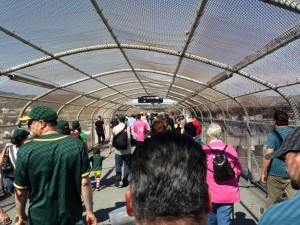
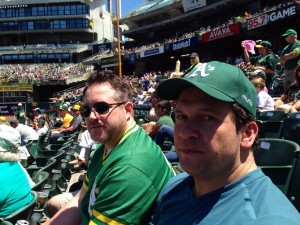
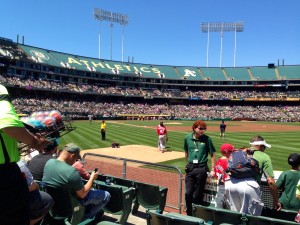
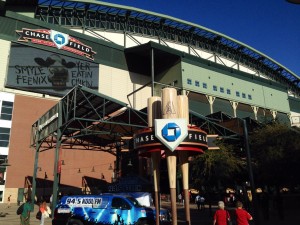

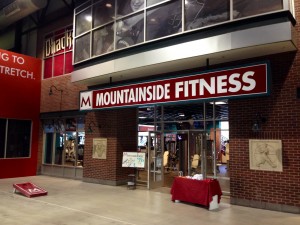
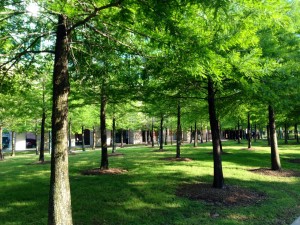
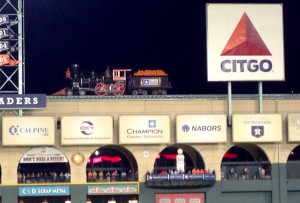
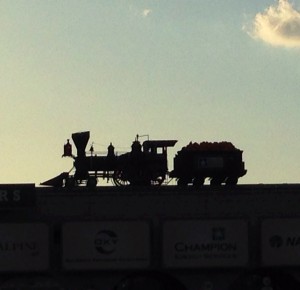





https://www.change.org/petitions/new-york-mets-fire-terry-collins
Hard not to feel badly for A’s fans…neglected team in a crap stadium in a city that has its challenges. If Beane didn’t have such a vendetta against the Mets I’d kind of root for them.
And glad to hear that what used to be Enron Field is perhaps ironically nice. Saw 2 games at the Astrodome and it was probably the weirdest place ever. Besides the oddball color scheme, felt like an expanded arena that was meant for anything but baseball.
Seen 2 games at Nationals Park in the past few weeks and I give it a thumbs up. About 10,000 places to buy food (including several CitiField headliners like Shake Shack and Blue Smoke) and employees who contradict DC’s reputation for combining northern charm and southern efficiency.
Superb reviews. It’s my goal to do all the parks, I’ll be doing Marlins and Phillies in 2 weeks time and am still considering the Trop as well. Minute Maid looks decent but the A’s, hmm, not so much
Great reviews Jason. My son was out in Scottsdale for business last week and caught the D’backs-Nats game as well….might have been the same one you were at (Strasburg started for the Nats).
“But it’s still a mall with baseball in it.”
He said pretty much the same thing. Nice place, but a little strange. He mentioned that ticket prices were pretty good and they didn’t kill you at the concession stand.
Nationals Park to me was eh. (Saw Nats/Mets around Labor day last year). Comerica is beautiful, but PNC in Pittsburgh is gorgeous.
My to-do list: Miami, Pittsburgh, Detroit, Cleveland, Cincy, Chicago (White Sox), Milwaukee, Minnesota, St. Louis, Kansas City, Texas.
After the Yankees series it occurred to me that the conventional wisdom about Citi Field may have it backwards. They should play in a bandbox. If they are emphasizing pitching over power-hitting as they say they are, strong pitching should presumably keep more balls in the yard than their adversaries, while shorter fences should help their weaker-than-average hitters. Thoughts?
Kudos for the D&D reference.
I attended two games in Oakland when I lived out there in the late 90’s, and did enjoy the games once i got inside. My take was the same as yours – great fans, atrocious park. (It helped that I was able to walk up 45 minutes before gametime and get field-level seats.) And I’m sure it’s worse now then when I was there 15 years ago.